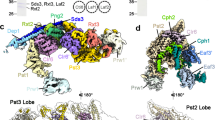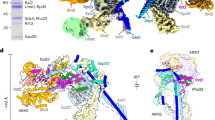Abstract
Sir2 is an NAD-dependent histone deacetylase that mediates transcriptional silencing at mating-type loci, telomeres and ribosomal gene clusters, and has a critical role in the determination of life span in yeast and Caenorhabditis elegans. The 1.7 Å crystal structure of the 323 amino acid catalytic core of human SIRT2, a homolog of yeast Sir2, reveals an NAD-binding domain, which is a variant of the Rossmann fold, and a smaller domain composed of a helical module and a zinc-binding module. A conserved large groove at the interface of the two domains is the likely site of catalysis based on mutagenesis. Intersecting this large groove, there is a pocket formed by the helical module. The pocket is lined with hydrophobic residues conserved within each of the five Sir2 classes, suggesting that it is a class-specific protein-binding site.
This is a preview of subscription content, access via your institution
Access options
Subscribe to this journal
Receive 12 print issues and online access
$189.00 per year
only $15.75 per issue
Buy this article
- Purchase on Springer Link
- Instant access to full article PDF
Prices may be subject to local taxes which are calculated during checkout




Similar content being viewed by others
Accession codes
References
Shore, D., Squire, M. & Nasmyth, K.A. EMBO J. 3, 2817–2823 (1984).
Ivy, J.M., Klar, A.J. & Hicks, J.B. Mol. Cell Biol. 6, 688–702 (1986).
Gottschling, D.E., Aparicio, O.M., Billington, B.L. & Zakian, V.A. Cell 63, 751–762 (1990).
Bryk, M. et al. Genes Dev. 11, 255–269 (1997).
Smith, J.S. & Boeke, J.D. Genes Dev. 11, 241–254 (1997).
Moretti, P., Freeman, K., Coodly, L. & Shore, D. Genes Dev. 8, 2257–2269 (1994).
Hecht, A., Laroche, T., Strahl-Bolsinger, S., Gasser, S.M. & Grunstein, M. Cell 80, 583–592 (1995).
Kaeberlein, M., McVey, M. & Guarente, L. Genes Dev. 13, 2570–2580 (1999).
Lin, S.J., Defossez, P.A. & Guarente, L. Science 289, 2126–2128 (2000).
Tissenbaum, H.A. & Guarente, L. Nature 410, 227–230 (2001).
Tanny, J.C., Dowd, G.J., Huang, J., Hilz, H. & Moazed, D. Cell 99, 735–745 (1999).
Imai, S., Armstrong, C.M., Kaeberlein, M. & Guarente, L. Nature 403, 795–800 (2000).
Landry, J. et al. Proc. Natl. Acad. Sci. USA 97, 5807–5811 (2000).
Smith, J.S. et al. Proc. Natl. Acad. Sci. USA 97, 6658–6663 (2000).
Tanner, K.G., Landry, J., Sternglanz, R. & Denu, J.M. Proc. Natl. Acad. Sci. USA 97, 14178–14182 (2000).
Cheung, P., Allis, C.D. & Sassone-Corsi, P. Cell 103, 263–271 (2000).
Wu, J. & Grunstein, M. Trends Biochem. Sci. 25, 619–623 (2000).
Finnin, M.S. et al. Nature 401, 188–193 (1999).
Tanny, J.C. & Moazed, D. Proc. Natl. Acad. Sci. USA 98, 415–420 (2001).
Brachmann, C.B. et al. Genes Dev. 9, 2888–2902 (1995).
Frye, R.A. Biochem. Biophys. Res. Commun. 273, 793–798 (2000).
Frye, R.A. Biochem. Biophys. Res. Commun. 260, 273–279 (1999).
Bellamacina, C.R. FASEB J. 10, 1257–1269 (1996).
Zheng, N., Wang, P., Jeffrey, P.D. & Pavletich, N.P. Cell 102, 533–539 (2000).
Min, J., Landry, J., Sternglanz, R. & Xu, R.M. Cell 105, 269–279 (2001).
Prasad, G.S., Sridhar, V., Yamaguchi, M., Hatefi, Y. & Stout, C.D. Nature Struct. Biol. 6, 1126–1131 (1999).
Cockell, M.M., Perrod, S. & Gasser, S.M. Genetics 154, 1069–1083 (2000).
Scheuring, J. & Schramm, V.L. Biochemistry 36, 8215–8223 (1997).
Cakir, K.-S.C., Muller-Steffner, H. & Schuber, F. Biochem. J. 349, 203–210 (2000).
Carroll, S.F. & Collier, R.J. Methods Enzymol. 235, 631–639 (1994).
Carroll, S.F. & Collier, R.J. Proc. Natl. Acad. Sci. USA 81, 3307–3311 (1984).
Douglas, C.M. & Collier, R.J. J. Bacteriol. 169, 4967–4971 (1987).
Otwinowski, Z. & Minor, W. Methods Enzymol. 276, 307–326 (1997).
Colllaborative Computational Project, Number 4. Acta Crystallogr. D 50, 760–763 (1994).
Jones, T.A., Zhou, J.-Y., Cowan, S.W. & Kjeldgaard, M. Acta Crystallogr. A 47, 110–119 (1991).
Brünger, A.T. et al. Acta Crystallogr. D 54, 905–921 (1998).
Kraulis, P. J. Appl. Crystallogr. 24, 946–950 (1991).
Merritt, E.A. & Bacon, D.J. Methods Enzymol. 277, 505–524 (1997).
Nicholls, A., Sharp, K.A. & Honig, B. Proteins Struct. Funct. Genet. 11, 281–296 (1991).
Acknowledgements
We thank V.M. Richon for the gift of the [3H]acetyl-labeled murine erythroleukemia cell-derived histone substrate; H. Erdument-Bromage of the Sloan-Kettering Microchemistry Facility for N-terminal sequence and mass spectroscopic analysis; C. Murray for administrative assistance; and the staff of the Cornell High Energy Synchotron Source MacChess for help with data collection. Supported by the NIH, the Howard Hughes Medical Institute, the Dewitt Wallace Foundation, the Samuel and May Rudin Foundation and the Rochelle Belfer Foundation.
Author information
Authors and Affiliations
Corresponding author
Rights and permissions
About this article
Cite this article
Finnin, M., Donigian, J. & Pavletich, N. Structure of the histone deacetylase SIRT2. Nat Struct Mol Biol 8, 621–625 (2001). https://doi.org/10.1038/89668
Received:
Accepted:
Issue Date:
DOI: https://doi.org/10.1038/89668
This article is cited by
-
In silico drug discovery of SIRT2 inhibitors from natural source as anticancer agents
Scientific Reports (2023)
-
Shedding light on structure, function and regulation of human sirtuins: a comprehensive review
3 Biotech (2023)
-
SIRT2-mediated deacetylation and deubiquitination of C/EBPβ prevents ethanol-induced liver injury
Cell Discovery (2021)
-
Drug repurposing for ligand-induced rearrangement of Sirt2 active site-based inhibitors via molecular modeling and quantum mechanics calculations
Scientific Reports (2021)
-
A short guide to histone deacetylases including recent progress on class II enzymes
Experimental & Molecular Medicine (2020)



